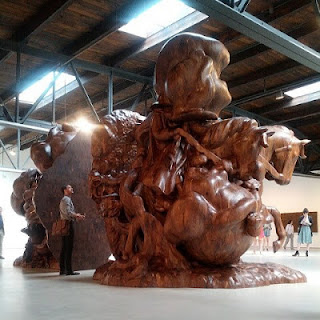Trudy Benson’s paintings directly evolve out of her relationship with rudimentary graphic programs such as Windows Paint and Brushes. Her original influence is founded in memories of exploring MacPaint on an old Mac SE as a child. The paintings found in PAINT blend perfectly Benson’s affinity to abstract painting and modern technology while also exploring a dialogue with classical painting motifs such as the venus pudica. There is an interesting hybrid of influence layered within these paintings, which at first glance can appear as a simple collage of abstract information. The artist’s shapes and strokes of the paintbrush adhere to no sense of gravity and a viewer will not find any horizon line to help position him or herself within the work. The longer an individual stands before one of Trudy Benson’s works the more the canvas reveals itself to the viewer a realm which exists uniquely between the digital and physical worlds.
Benson’s paintings like a computer screen contain a strange sense of flattened, shallow space. Yet, her heavy application of paint and materials places a viewer in a visual playground of real and illusionary space, which is not contained in the digital counterpart. The artist’s exploration of space in painting continues with her adaptation of the city’s technique of cleaning up graffiti in neighborhoods, where large paint rollers are used to “paint out” the graffiti. The graffiti removal technique functions similarly to the notion of a ‘portable hole,’ a visual trope that Benson is also engaging in this new body of work. Benson utilizes the masking of an under painting, or censuring like in the venus pudica, to draw more attention and inquiry to what is hidden beneath the newest layer of paint. To unlock this exhibition it is key to make note of the artist’s use of “reductive techniques, which contain an additive value.” There is no edit > undo for Trudy Benson’s paintings. Every layer and texture of the canvas is embraced; each painting rendering an honest tangible representation of it’s own history.
Try moving the origin of your next painting to a different place. See you next week, john.






.jpg)

